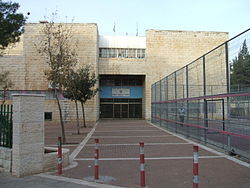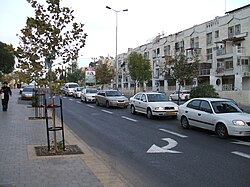Shmuel HaNavi (neighborhood)
 From Wikipedia - Reading time: 11 min
From Wikipedia - Reading time: 11 min

Shmuel HaNavi (Hebrew: שיכון שמואל הנביא, Shikun Shmuel HaNavi, lit. "Samuel the Prophet neighborhood") is a neighborhood in north-central Jerusalem. It is bordered by the Sanhedria Cemetery to the north, Maalot Dafna to the east, Arzei HaBira to the south, and the Bukharan Quarter to the west. It is named after Shmuel HaNavi (Samuel the Prophet) Street, which runs along its western border and is the main road leading to the tomb of Samuel the prophet (Hebrew: Shmuel HaNavi) just outside Jerusalem's city limits.[1]
Background
[edit]

The first home to be erected on what would become known as Shmuel HaNavi Street was the Mandelbaum House, a large, three-story house built by Simcha Torever-Mandelbaum, a Jerusalem textile merchant, in 1927. Mandelbaum chose the location at the eastern end of the street, facing Sheikh Jarrah, with a desire to expand the northern boundary of Jewish Jerusalem at that time.[2][3] In 1941, the Jerusalem Biblical Zoo, initially a small children's zoo on Harav Kook Street in central Jerusalem, was moved to a 4.5 dunams (0.45 ha) tract at the eastern end of Shmuel HaNavi Street before relocating to the campus of the Hebrew University on Mount Scopus in 1947.[4][5] Houses built at the eastern end of the street before 1948 were largely inhabited by poor families and subject to sniper fire from Sheik Jarrah during the 1947 civil war.[6] When war broke out in 1948, Shmuel HaNavi Street became a strategic gateway for Arab Legionnaires seeking to enter Jewish Jerusalem.[7] The Mandelbaum House was used by the Haganah as a military stronghold and was partially blown up by the Arab Legion.[8]
The 1949 Armistice Agreements put Shmuel HaNavi Street parallel to the Jordanian border, with a no man's land of barbed wire and minefields separating it from Ammunition Hill to the northeast.[9][10] From 1949 to 1967 the official crossing point between Israeli- and Jordanian-held territory stood at the eastern end of Shmuel HaNavi Street at a checkpoint called the Mandelbaum Gate. This checkpoint was named after the destroyed Mandelbaum House, whose ruins lay nearby.[11][12]
New construction
[edit]
In the 1950s the new state of Israel struggled to absorb large numbers of immigrants, moving them out of temporary tents and huts into permanent apartments. Shmuel HaNavi was one of the neighborhoods built to accommodate these immigrants.[13] Constructed in the early 1960s,[14] it was situated next to the 1949 armistice line that ran parallel to Shmuel HaNavi Street, in order to reinforce the city's hold on its northern border.[9]
Considering the location, the complex of "long train" tenement buildings were built in the manner of fortresses.[15] The buildings were erected on a base of reinforced concrete and the walls were finished in rough stone, since this type of material could be handled by hundreds of unskilled workers.[16] The Israel Housing Ministry mandated that the external concrete walls of the buildings be three times the normal thickness to withstand shelling.[17] The roofs of the buildings had raised parapets fitted with gun slots.[15] The buildings themselves were arranged in a "confusing zig-zag pattern" to slow down Arab armies that might charge the complex,[18] and the courtyards between the buildings were designed to accommodate mass mobilization of Israeli troops in the event of an attack.[15] For many years, residents barricaded their building entrances with sandbags and reinforced or blocked windows exposed to the border with Jordan.[19]

The project was largely populated by Sephardi Jewish immigrants from North Africa.[20] The buildings – each "four stories in height, 32 apartments to a building, containing small flats of 70 meters housing large families"[21] – suffered from overcrowding[1] and lack of infrastructure, and quickly turned into a slum.[22][23]
Urban protest movement
[edit]By the late 1970s, when the population had reached 4,000, a significant number of youth had dropped out of school and organized themselves into gangs. In response, Ohalim, an urban protest movement that promoted "positive activity" among disadvantaged immigrant populations in Jerusalem, established a community council in Shmuel HaNavi, along with similar councils in Nachlaot, Baka, and Kiryat Yovel, between 1977 and 1981.[20] The Shmuel HaNavi branch called itself Ohel Shmuel. It "organized neighborhood clean-up campaigns, helped rid one of the buildings of prostitutes, organized cultural activities and holiday celebrations, initiated activities for the elderly, helped involve marginal youth in productive activity by setting up a lighting fixture factory for them, and organized learning centers for children and youth".[24]
Project Renewal upgrade
[edit]In 1968, a year after the Six-Day War and the reunification of Jerusalem, a community center opened in the neighborhood.[25] Shmuel HaNavi underwent a significant upgrade under Project Renewal, a national urban renewal program that upgraded housing, infrastructure and utilities in 84 Israeli neighborhoods between 1977 and 1984.[26] A new facade was added to each building in the complex, and apartments were enlarged and even combined to create larger living quarters.[1] The Jewish Agency for Israel, a Project Renewal co-partner, paired cities in the United States with Israeli neighborhoods slated for rehabilitation;[27] Washington, D.C. was twinned with Shmuel HaNavi.[28]
Demography
[edit]
As the first generation of immigrant children matured and left the neighborhood, their parents followed, and Haredi families from Mea Shearim, Bukharim and Geula took their place. Today the Shmuel HaNavi neighborhood is largely Haredi.[1] The neighborhood has deteriorated over the past number of decades, however, due to the low socioeconomic level of its residents. In 2007, a 3-room apartment was selling for $70,000 to $100,000.[29]
Archaeology
[edit]Sanhedrin Park, north of the Shmuel HaNavi-Bar Ilan intersection, contains burial caves from the Second Temple period.[30] In 2009, archaeologists discovered an ancient quarry dating to the end of the Second Temple period (c. 2,030 years old) on Shmuel HaNavi Street near the Shmuel HaNavi neighborhood. According to the Israel Antiquities Authority, the immense size of the stones suggests that they were destined for use in the construction projects of King Herod, including the Temple. The Shmuel HaNavi quarry is part of a series of stone quarries stretching over the entire slope, from Musrara to Sanhedria.[31][32]
Notable residents
[edit]- Eliyahu Amedi, a yeshiva student whose 1986 murder sparked five days of anti-Arab rioting in and around the Old City.[33]
- Yaakov Yosef, rabbi, rosh yeshiva, and former Knesset member for the Shas party[34]
- Puah Shteiner, author of Forever My Jerusalem
See also
[edit]References
[edit]- ^ a b c d "Jerusalem Neighborhoods: Shmuel Hanavi". Jerusalem Municipality. 22 August 2011. Retrieved 20 March 2012.
- ^ Rossoff, Dovid (2001). Where Heaven Touches Earth: Jewish life in Jerusalem from medieval times to the present (6th ed.). Feldheim Publishers. pp. 553–554. ISBN 0873068793. Archived from the original on 7 May 2021. Retrieved 8 May 2021.
- ^ Porush, Eliyahu (1963). "Early Memories: Recollections Concerning the Settlement of Jerusalem, The Old City and Its Environs During the Last Century". University of Pennsylvania Scholarly Commons. p. 13. Archived from the original on 25 July 2010. Retrieved 15 April 2012.
- ^ Greenbaum, Avraham (August 2006). "The Jerusalem Biblical Zoo". Society of Biblical Literature. Archived from the original on 24 January 2014. Retrieved 28 November 2010.
- ^ "Jerusalem Biblical Zoo: The Tisch Family Zoological Gardens in Jerusalem". Jewish Virtual Library. 2012. Retrieved 15 April 2012.
- ^ Shteiner, Pu’ah (1987). Forever My Jerusalem: A personal account of the siege and surrender of Jerusalem's Old City in 1948. Feldheim Publishers. p. 62. ISBN 0873063945.
- ^ Lapidot, Yehuda. "The Arab Legion Attacks Jerusalem". daat.ac.il. Archived from the original on 10 May 2012. Retrieved 25 March 2012.
- ^ Rossoff (2001), p. 555.
- ^ a b Bar-Am, Aviva; Rechtman, Gershon (1999). Jerusalem Easywalks. Ingeborg Rennet Center for Jerusalem Studies. p. 104. ISBN 9659004869.
- ^ "Memories From Ammunition Hill". UJA Federation of Greater Toronto. 16 May 2004. Archived from the original on 2 January 2014. Retrieved 25 March 2012.
- ^ Regev, Chaya. "The Mandelbaum Gate: Home of the Mandelbaum Family". Yated Ne'eman (Israel-English edition), 5 November 2004, pp. 16–18.
- ^ "Mandelbaum Gate". Eretz Yisrael Museum. 2011. Archived from the original on 17 August 2013. Retrieved 20 March 2012.
- ^ "Housing Projects in Israel". Samuel Neaman Institute for National Policy Research. Archived from the original on 14 June 2015. Retrieved 20 March 2012.
- ^ Hyman, Benjamin; Kimhi, Israel; Savitzky, Joseph (1985). Jerusalem in transition: Urban growth & change, 1970's-1980's. The Institute of Urban and Regional Studies, The Hebrew University of Jerusalem. p. 7.
- ^ a b c Kroyanker, David (8 October 2001). "Fence and Defense". Haaretz. Archived from the original on 21 April 2016. Retrieved 20 March 2012.
- ^ Wechsler, Gadi. מעיר חצויה לעיר מאוחדת: משכונת שמואל הנביא להר הצופים [From a Divided City to a Unified City: The Shmuel HaNavi neighborhood to Mount Scopus] (in Hebrew). Yad Ben-Zvi. Archived from the original on 16 July 2012. Retrieved 15 April 2012.
- ^ "Israel and Palestine" (155–162). 1990: xxxi.
{{cite journal}}: Cite journal requires|journal=(help) - ^ Israel scene, Volumes 6–8. World Zionist Organization, American Section. 1985. p. 14.
- ^ Israeli (2002), p. 109.
- ^ a b Hasson (1993), p. 12.
- ^ Greenberg, Harold I.; Granot, Hayim; Nadler, Samuel (1977). Poverty in Israel: Economic realities and the promise of social justice. Praeger. p. 77. ISBN 0275243001. Archived from the original on 2022-04-07. Retrieved 2023-08-19.
- ^ Yanow, Dvora (1996). How Does a Policy Mean?: Interpreting policy and organizational actions. Georgetown University Press. p. 117. ISBN 0878406123. Archived from the original on 2023-08-19. Retrieved 2023-08-19.
- ^ Israeli (2002), p. 123.
- ^ Hasson (1993), p. 80.
- ^ רשימת מתנסים [List of Community Centers] (in Hebrew). The Israel Association of Community Centers. Archived from the original on 10 October 2013. Retrieved 25 March 2012.
- ^ Avruch, Kevin; Zenner, Walter P. (1997). Critical Essays on Israeli Society, Religion, and Government. SUNY Press. p. 57. ISBN 079143253X. Archived from the original on 2021-05-21. Retrieved 2023-08-19.
- ^ Center for Jewish Community Studies (January 1980). "Project Renewal: An introduction to the issues and actors". Berman Jewish Policy Archive. Archived from the original on 13 August 2010. Retrieved 20 March 2012.
- ^ Hoffman, Charles (1989). The Smoke Screen: Israel, philanthropy, and American Jews. Eshel Books. p. 160. ISBN 093543724X.
- ^ Mirovsky, Eric (20 April 2007). משיכון עולים לשכונות יוקרה [From an Immigrant Development to Luxury Neighborhoods]. Haaretz (in Hebrew). Archived from the original on 19 August 2023. Retrieved 15 April 2012.
- ^ "Jerusalem Parks and Gardens". Jerusalempedia. Archived from the original on 4 May 2012. Retrieved 15 April 2012.
- ^ "A Large Stone Quarry from the End of the Second Temple Period was Exposed on Shmuel HaNavi St. in Jerusalem". Israel Antiquities Authority. Archived from the original on 22 February 2014. Retrieved 22 March 2012.
- ^ Lis, Jonathan (7 July 2009). "Discovered Quarry May Have Supplied Second Temple Stones". Haaretz. Archived from the original on 6 January 2010. Retrieved 22 March 2012.
- ^ Broder, Jonathan (21 November 1986). "Anti-Arab Rioting Grows In Jerusalem". Chicago Tribune. Archived from the original on 4 March 2016. Retrieved 20 March 2012.
- ^ Lidman, Melanie (1 July 2011). "Hundreds gather over rumors of Rabbi Yaakov Yosef's arrest". The Jerusalem Post. Archived from the original on 17 February 2013. Retrieved 20 March 2012.
Bibliography
[edit]- Hasson, Shlomo (1993). Urban Social Movements in Jerusalem: The protest of the second generation. SUNY Press. ISBN 0791414280.
- Israeli, Raphael (2002). Jerusalem Divided: The armistice regime, 1947–1967. Routledge. ISBN 0714652660.
 KSF
KSF